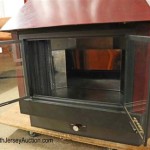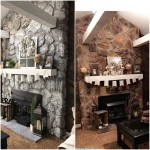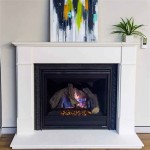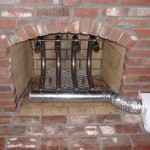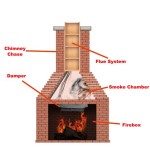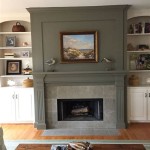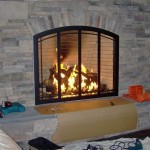Installing a Gas Fireplace in an Existing Fireplace: A Comprehensive Guide
The allure of a crackling fire on a cold evening is undeniable, and a gas fireplace offers a convenient and efficient alternative to traditional wood-burning fireplaces. Installing a gas fireplace within an existing fireplace structure can significantly enhance the aesthetic appeal and heating capabilities of a home. This article provides a detailed overview of the process, considerations, and potential challenges involved in such an installation.
Before commencing any work, a thorough assessment of the existing fireplace and chimney is paramount. This evaluation should identify any structural deficiencies, such as cracks, crumbling brickwork, or blockages within the flue. Addressing these issues before installing the gas fireplace is crucial for ensuring safe and efficient operation. Additionally, verifying local building codes and obtaining necessary permits is a mandatory step. Failure to comply with regulations can result in costly fines and potential safety hazards.
The selection of an appropriate gas fireplace insert is a critical decision. Factors to consider include the size of the existing fireplace opening, the desired heating output (measured in BTU - British Thermal Units), the venting requirements of the chosen insert, and the aesthetic style. Gas fireplace inserts are available in a range of sizes, styles, and fuel types (natural gas or propane). Selecting an insert that is too large or incompatible with the existing fireplace can lead to installation complications and performance issues.
Key Point 1: Pre-Installation Assessment and Planning
A successful gas fireplace installation hinges on meticulous pre-installation assessment and planning. This includes a thorough inspection of the existing fireplace and chimney, verification of local building codes, and selection of a suitable gas fireplace insert. The chimney inspection should check for structural integrity, including cracks, deterioration of mortar joints, and any obstructions that could impede proper venting. A professional chimney sweep can provide a detailed inspection report and recommend necessary repairs.
Building codes dictate the specific requirements for gas fireplace installations, including venting specifications, gas line connections, and safety clearances. Contacting the local building department is essential to obtain the necessary permits and ensure compliance with all applicable regulations. The gas fireplace insert's venting requirements are crucial. Some inserts require direct venting, which involves running a vent pipe directly to the exterior of the house, while others can be vented through the existing chimney using a liner. The choice of venting method will depend on the insert's specifications and the condition of the existing chimney.
Matching the gas fireplace insert to the aesthetic of the existing fireplace and the homeowner's preferences is also important. Inserts are available in various styles, from traditional log sets to contemporary glass media. Considering the overall design of the room and the homeowner's taste will ensure that the gas fireplace seamlessly integrates into the existing decor.
Key Point 2: Gas Line Installation and Venting
One of the most critical aspects of installing a gas fireplace is the gas line connection. This task should only be performed by a qualified and licensed gas fitter. Improper gas line installation can lead to gas leaks, which pose a significant fire and explosion risk. The gas fitter will need to run a gas line from the existing gas supply to the fireplace location, ensuring that the line is properly sized and connected. A shut-off valve should be installed near the fireplace for safety and maintenance purposes.
Venting is equally critical for the safe and efficient operation of a gas fireplace. The type of venting required will depend on the specific gas fireplace insert. Direct vent inserts require a sealed venting system that draws combustion air from outside the house and exhausts combustion byproducts directly outside. This type of venting is generally considered the safest and most efficient option. Chimney vent inserts utilize the existing chimney, but often require the installation of a chimney liner to ensure proper venting and prevent corrosion of the chimney structure.
The chimney liner should be sized appropriately for the gas fireplace insert and installed according to the manufacturer's instructions. If the existing chimney is in poor condition, it may need to be repaired or replaced before a liner can be installed. Ensuring proper venting is paramount for preventing carbon monoxide buildup and ensuring the safe operation of the gas fireplace.
Key Point 3: Installation of the Gas Fireplace Insert and Finishing Touches
Once the gas line and venting are in place, the gas fireplace insert can be installed into the existing fireplace opening. The insert should be securely positioned and leveled according to the manufacturer's instructions. The connections between the gas line and the insert should be carefully checked for leaks using a gas leak detector. Any leaks should be immediately addressed by a qualified gas fitter.
After the insert is installed, the finishing touches can be added to enhance the aesthetic appeal of the fireplace. This may include installing a decorative surround, adding a mantel, or applying a new coat of paint or stucco to the fireplace facade. The goal is to create a cohesive and visually appealing focal point in the room. The choice of finishing materials should be compatible with the heat generated by the gas fireplace and should comply with local building codes.
Before using the gas fireplace for the first time, it is important to perform a thorough test run to ensure that it is operating correctly. This includes checking the flame pattern, verifying the venting system's proper function, and monitoring for any unusual odors or sounds. A qualified gas fitter should be consulted if any problems are detected.
Regular maintenance is essential for the long-term performance and safety of a gas fireplace. This includes annual inspections by a qualified technician to check the venting system, gas line connections, and burner assembly. The fireplace should also be cleaned regularly to remove dust, debris, and soot that can accumulate over time. Following the manufacturer's recommendations for maintenance will help to ensure the continued safe and efficient operation of the gas fireplace.
In conclusion, installing a gas fireplace in an existing fireplace is a complex project that requires careful planning, attention to detail, and adherence to all applicable building codes. Engaging qualified professionals, such as gas fitters and chimney sweeps, is crucial for ensuring a safe and successful installation. By following these guidelines, homeowners can enjoy the warmth and ambiance of a gas fireplace for years to come.

Adding A Gas Fireplace To An Existing Home Just Log Fires

Existing Fireplace Or A Brand New Build Lopi Fireplaces

Convert To Gas Installing Fireplace Inserts Doctor Flue

Can I Install Gas Logs In My Existing Fireplace Thomas Bros Propane

Adding A Fireplace To Existing Home Where For Fireplaces

How To Install A Gas Fireplace Insert

Existing Fireplace Or A Brand New Build Lopi Fireplaces
-small.gif?strip=all)
How To Replace Your Old Open Fire With A New Efficient Gas Fireplace

How To Install A Gas Fireplace This Old House

How To Install An Electric Fireplace Insert Fireplaces Direct Learning Center
Related Posts

